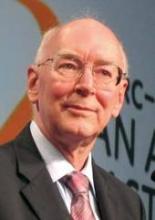SAN ANTONIO – Women who received paclitaxel and trastuzumab after anthracycline chemotherapy for HER2-positive breast cancer were almost 40% less likely to die by 10 years than were those given only paclitaxel in a pair of landmark clinical trials.
"This means that 80% of these patients – most of whom had node-positive disease – were alive at 10 years after their diagnosis of breast cancer." said Dr. Edward H. Romond, reporting long-term findings at the annual San Antonio Breast Cancer Symposium.
The regimen also reduced the risk of a 10-year disease-free survival event by 40% in the definitive survival analysis of the two pivotal trastuzumab (Herceptin) studies – the National Surgical Adjuvant Breast and Bowel Project (NSABP) B-31 protocol and the North Central Cancer Treatment Group (NCCTG) N9831 trial.
Both studies compared the paclitaxel/trastuzumab combination with paclitaxel alone in women with invasive HER2-positive breast cancers. All patients had undergone a lumpectomy or mastectomy with pathologically clear margins, and had axillary nodes that were initially pathologically involved.
Outcomes of both trials have been separately reported. However, because of their similar structure, treatment regimens, and patient populations, the Food and Drug Administration agreed to combine them to allow for a definite survival analysis, said Dr. Romond of the University of Kentucky, Lexington.
The combined analysis comprised 4,046 patients, 2,028 of whom took the paclitaxel/trastuzumab combination and 2,018 of whom took paclitaxel alone. The median follow-up in the combined analysis was 8.4 years, with data available for up to 10 years.
About half of the patients were younger than 50 years. Most had node positive disease; slightly more than half had hormone receptor positive–breast cancer. The tumor was T1 in 40%, T2 in 50%, and T3 in 10%.
By the end of the follow-up period, 680 disease-free survival events had occurred in the paclitaxel-only group vs. 473 in the combination therapy group (hazard ratio, 0.60; P less than .0001).
The disease-free survival curve began to separate shortly before year 2. The difference became significant around year 5; by year 6, 81% of the combination group and 69% of the single-therapy group were without an event. By year 10, the rates of disease-free survival were 74% and 62% - an absolute difference of 11.5%.
Most events in each group were distant recurrences (227 with the combination and 391 with single-therapy). Local or regional recurrence was seen in 84 and 124, respectively, and contralateral breast disease in 46 and 40. About 4% of women in each group developed a second primary cancer, and about 2% in each group died without a recurrence of their breast cancer.
There were 286 deaths in the combination group and 418 in the paclitaxel-only group. Women in the combination-therapy group were 37% less likely to die than were those who took paclitaxel alone – a significant difference (HR, 0.63; P less than .0001)
The survival curves began to diverge around year 2 and continued to separate throughout the follow-up period. By year 10, 84% of those in the combination group and 75% of those in the single therapy group were still alive, an absolute difference of 9%.
The survival advantage was apparent whether women had hormone receptor positive or negative disease, Dr. Romond noted (HR, 0.61 and 0.64, respectively).
Most deaths in both groups were due to the original breast cancer (209 in the combination group and 340 in the paclitaxel-only group). Other causes of death were a second primary cancer (25 and 41, respectively), or other or unknown causes.
The combination treatment was especially helpful for women with high risk factors, conferring a significant survival advantage over paclitaxel alone to women aged 60 years and older (14%), women with 10 more positive nodes (16%), and women with tumors larger than 5 cm (12%).
Dr. Romond had no financial disclosures.


